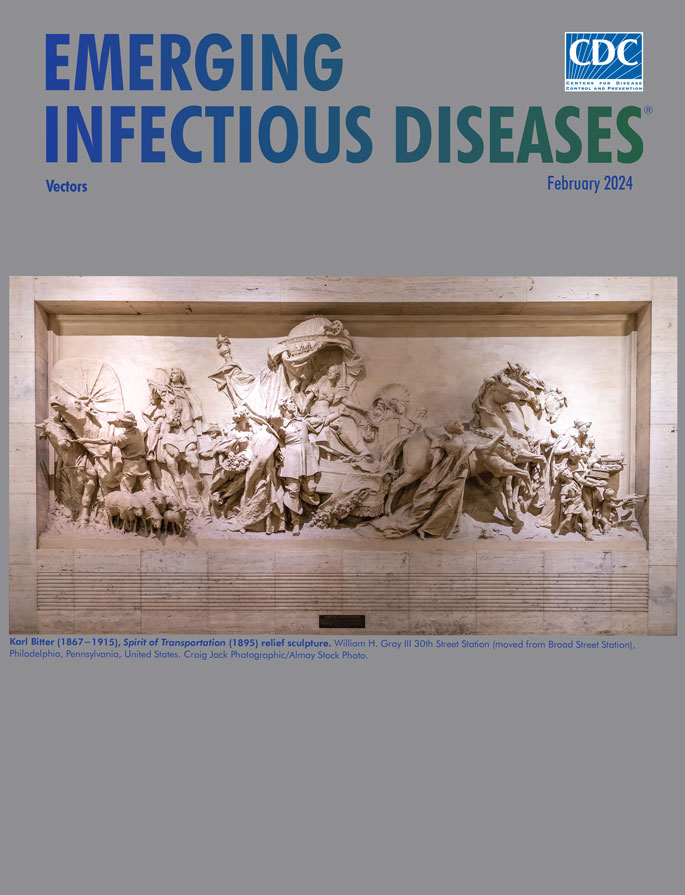Attachment Patterns of Avian Influenza H5 Clade 2.3.4.4b Virus in Respiratory Tracts of Marine Mammals, North Atlantic Ocean.
IF 6.6
2区 医学
Q1 IMMUNOLOGY
引用次数: 0
Abstract
Highly pathogenic avian influenza A(H5N1) clade 2.3.4.4b virus infections have caused substantial mortality events in marine mammals in recent years. We hypothesized that the high number of infections and disease severity could be related to cell tropism in respiratory tracts. Therefore, we examined the attachment pattern of an H5N1 clade 2.3.4.4b virus (H52022) as a measure for cell tropism in the respiratory tracts of harbor seals, gray seals, harbor porpoises, and bottlenose dolphins and compared it with an H5N1 clade 2.1.3.2 virus (H52005) and a human seasonal H3N2 virus using virus histochemistry. Both H5 viruses attached abundantly to olfactory and respiratory mucosa in the upper respiratory tract of both seal species. H52022 attached more abundantly than H52005 to epithelial cells in the lower respiratory tract of all species. The observed attachment possibly explains the susceptibility of marine mammal species for recent H5N1 viruses and the observed development of severe disease.北大西洋海洋哺乳动物呼吸道中禽流感H5分支2.3.4.4b病毒的附着模式
近年来,高致病性禽流感A(H5N1)分支2.3.4.4b病毒感染在海洋哺乳动物中造成了大量死亡事件。我们假设高感染率和疾病严重程度可能与呼吸道的细胞趋向性有关。因此,我们研究了H5N1分支2.3.4.4b病毒(H52022)在斑海豹、灰海豹、港湾鼠海豚和宽吻海豚呼吸道中的附着模式,并利用病毒组织化学将其与H5N1分支2.1.3.2病毒(H52005)和人类季节性H3N2病毒进行了比较。两种海豹上呼吸道的嗅粘膜和呼吸道粘膜都有大量的H5病毒附着。在所有物种的下呼吸道中,H52022比H52005更丰富地附着在上皮细胞上。观察到的附着现象可能解释了海洋哺乳动物物种对最近的H5N1病毒的易感性和观察到的严重疾病的发展。
本文章由计算机程序翻译,如有差异,请以英文原文为准。
求助全文
约1分钟内获得全文
求助全文
来源期刊

Emerging Infectious Diseases
医学-传染病学
CiteScore
17.30
自引率
1.70%
发文量
505
审稿时长
1 months
期刊介绍:
Emerging Infectious Diseases is a monthly open access journal published by the Centers for Disease Control and Prevention. The primary goal of this peer-reviewed journal is to advance the global recognition of both new and reemerging infectious diseases, while also enhancing our understanding of the underlying factors that contribute to disease emergence, prevention, and elimination.
Targeted towards professionals in the field of infectious diseases and related sciences, the journal encourages diverse contributions from experts in academic research, industry, clinical practice, public health, as well as specialists in economics, social sciences, and other relevant disciplines. By fostering a collaborative approach, Emerging Infectious Diseases aims to facilitate interdisciplinary dialogue and address the multifaceted challenges posed by infectious diseases.
 求助内容:
求助内容: 应助结果提醒方式:
应助结果提醒方式:


